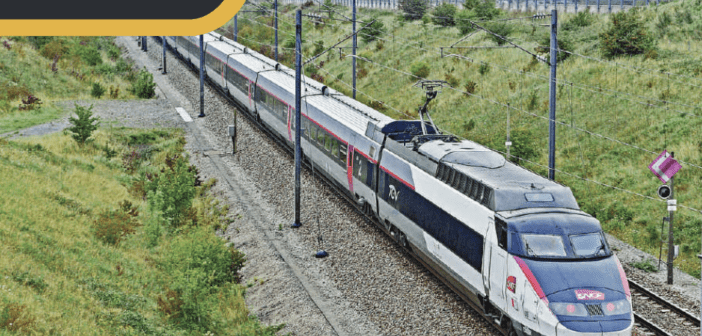By CPA Frederick Mutuku
There are Plans to Develop a High-Speed Rail Transport Network throughout the Continent
All regions of the world heavily depend on railway transport for their socio-economic development. Accelerated growth of industrialisation and trade especially in the Europe, North America and Asia has always been well facilitated by railway networks. Railway transport is the most suited mode for the conveyance of bulky freight over long distances. Furthermore, railway transport has a great potential to help minimise the extensive and costly deterioration of road infrastructure in the continent (Africa Union)
The rail transport is relatively affordable, safe and efficient compared to other modes of transport. Despite this commonplace knowledge successive African leaders and development partners have not paid keen attention to the nurturing and development of this transport network throughout the Africa region. I see a great opportunity for exponential growth throughout the continent of Africa if a deliberate effort is taken to develop the network. Perusing through recent developments and actions by African leaders and their development partners we find a bankable goodwill. How I wish this goodwill translates to concrete actions.
It is gratifying to find out that a plan is in place to develop a high-speed rail transport network throughout the continent. “The African Union Commission, in collaboration with the RECs, AfDB, UNECA and specialised institutions, is working on promoting and facilitating development of railway transport under its Programme for Infrastructure Development in Africa (PIDA) focuses on promoting the development of an integrated transport network for the continent which capitalises on the suitability of each mode of transport. In this context, railways have always been considered as the backbone of the transport networks at all levels”.
But what is the current rail transport situation in the continent and what could be done to support the brilliant idea of networking the entire Africa? What are the stumbling blocks? What benefits could accrue to the countries?
In East Africa we have two main transport corridors, the Northern and Central, each of the international corridors consists of two modes—road and railway. Of the two transport modes, the condition of the road corridor is mostly good or fair except for several sections, which are either under development or under rehabilitation, while the railway corridor suffers from reduced capacity attributable to a lack of investment and maintenance in track and rolling stock. Because of the competitive prices for railway freight transport relative to those of road transport, railway transport volumes exceed carrying capacity, resulting in as long as two months in waiting time for shipments on particular lines.
The main issues of the Northern Railway Corridor include: (i) insufficient rolling stock capacity, (ii) poorly maintained track, and (iii) lower service speeds, which have led to extreme under capacity in relation to increasing railway traffic demand. At present, the dwell time for inland-bound freight is sometimes as long as two months. This relatively long freight transport times and high transport costs pose bottlenecks to economic growth, trade, and private capital investment promotion.
This is definitely not an encouraging situation and not good at all for business, two weeks leave alone two months is a lot of time for a business. This calls for an overhaul of the outdated rail network and upgrading the same to more modern efficient and faster systems obtainable in other regions in the world. When this is done we will experience increased travels across the continent and faster delivery of goods across the continent. The current situation of very expensive air-travel doesn’t allow most people to travel across the continent. Just imagine what it would be like to have an electric train that covers the breath and length of the continent in a matter of days if not hours. The kind of efficiency that would be achieved, the mobility of our people and goods across the continent, reduced cost of doing business and definitely increased levels of employment, local tourism and definitely dignified lives for our people etc.
However, for these to be achievable we have to shed some bad manners as a continent. Our bad manners are numerous and like it is a requirement in many spheres in life, we must get lighter, abandon bad habits, and reduce the unnecessary baggage to be able to fly or swim lighter. Let me stop beating about the bush and go straight to the core of the problem. I hope what I believe to be the main problem facing our continent and derailing development is the real problem and not the symptoms of the problem.
Self-interest, egoism, and pride compound the main problem which is lack of goodwill by the leaders. Africa must speak with one voice and act together on this matter of the mammoth railway network across Africa. The quote below is a clear indication of the lack goodwill, while the groundwork has been laid, lethargy and inaction seems to be the order of the day.
“Continent-wide instruments include: (i) the African Union Treaty (the Constitutive Act of the African Union, Lomé, 2001), pursuant to which the African Union has made provisions in its priority program for Linking Africa for an Integrated Continental Transport Master Plan; (ii) the Treaty of Abuja (1991), which established the African Economic Community, by which the contracting states are to promote the integration of infrastructure and develop transport coordination to increase productivity and efficiency; (iii) the African Maritime Transport Charter (Tunis, 1994); and (iv) the Treaty on the Harmonization of Business Law in Africa (Port Louis, 1993), which covers transport laws, but which to date only includes civil law countries”
I don’t know if the cause of the inaction and inability to forge a united front as a continent is brought about by nursing of the overdose of colonization or it’s the constipation of the neo-colonization. To put this into context, we look at the 1991 Abuja Treaty, which envisaged acceleration of continental integration. The vision reads as follows; “An integrated Africa where transport infrastructure and services serve free movement of goods and passengers by providing options for safe, reliable and seamless transport; with reduced costs in support of sustainable regional economic development and protection of the environment”. A brilliant vision, excellent, superb, but wait a minute, the year is 1991 and what do we have to show, many years later? Your guess is as good as mine.
Let me at least be fair and give credit were due. Literature review has shown that, some progress has been made culminating in signing of an MOU with China but I have a problem with the speed. What is so difficult in appointing members to the committee of experts? So many countries are yet to do this simple task. China is a trailblazer in matters rail transport if the following quote is anything to go by; “China has emerged as the leading country in railway development. As of 2013, the country had 103,144 km of railways, the third longest network in the world, including 11,028 kilometres of high-speed rail (HSR), and the longest HSR network in the world. All provinces and regions except one are connected to the rail network. Almost all rail operations are handled by the China Railway Corporation.” Just imagine that kind of efficiency in transport systems in this country, compare that with the many man-hours wasted in a very slow moving train in some part of Africa or the dangerous road transport not to mention the expensive air-travel.
The Kenyan Standard Gauge Rail (SGR) from Mombasa which was planned to extend to South Sudan, DR Congo and Burundi has shown us what can be achieved through high-speed rail transport at least if you compare its efficiency with the metric- gauge rail which covers a greater part of the country. Though the dream of taking it beyond Naivasha is still that, we can confidently say it is a wise decision to expand it to neighbouring countries. The expansion of SGR to western Kenya will bring more efficiency and make it possible for the food baskets of Kenya to supply other parts of the country with so much needed foodstuffs.
If the SGR was expanded and the inter-connections made with other areas as networked with the metre-gauge, business would be enhanced a hundred-fold. Maybe this expansion could wake up the rest of regions in the continent. I say this with full knowledge that the Northern and Southern African regions have made some progress but this is not good enough. Let our leaders take a bold step and walk the remaining steps to give Africans this masterpiece and they will forever be remembered.
The entire African railway network estimated at about 75,000 km on a surface of 30.2 million km², translates into a density of approximately 2.5 km for 1000 km², which is far below that of other regions and the world average of 23 for 1000 km². These statistics speak volumes. The African density combined doesn’t get close to the world average. A lot of work is required to make necessary milestones.
| REGION | TOTAL NETWORK ROUTE KM | DENSITY KM/1000 Km² |
| NORTH AFFRICA | 16,012 | 2.3 |
| EASTERN AFRICA | 9341 | 2.2 |
| SOUTHERN AFRICA | 33291 | 5.6 |
| CENTRAL AFRICA | 6414 | 1.2 |
| WEST AFRICA | 9715 | 1.9 |
| AFRICA TOTAL | 74,775 | 2.5 |
| SOUTH ASIA | – | 18.8 |
| WORLD AVERAGE | – | 23.1 |
| HIGH INCOME COUNTRIES | – | 46.2 |
Source: World Bank
Ooh Africa wake up and smell the coffee.
References
Towards the African Integrated High Speed Railway Network (AIHSRN) development (African Union, N.D)
The Research on the Cross-Border Transport Infrastructure: Phase 3, “An Analysis of Cross-Border Transport Systems in East Africa” (N.D)




